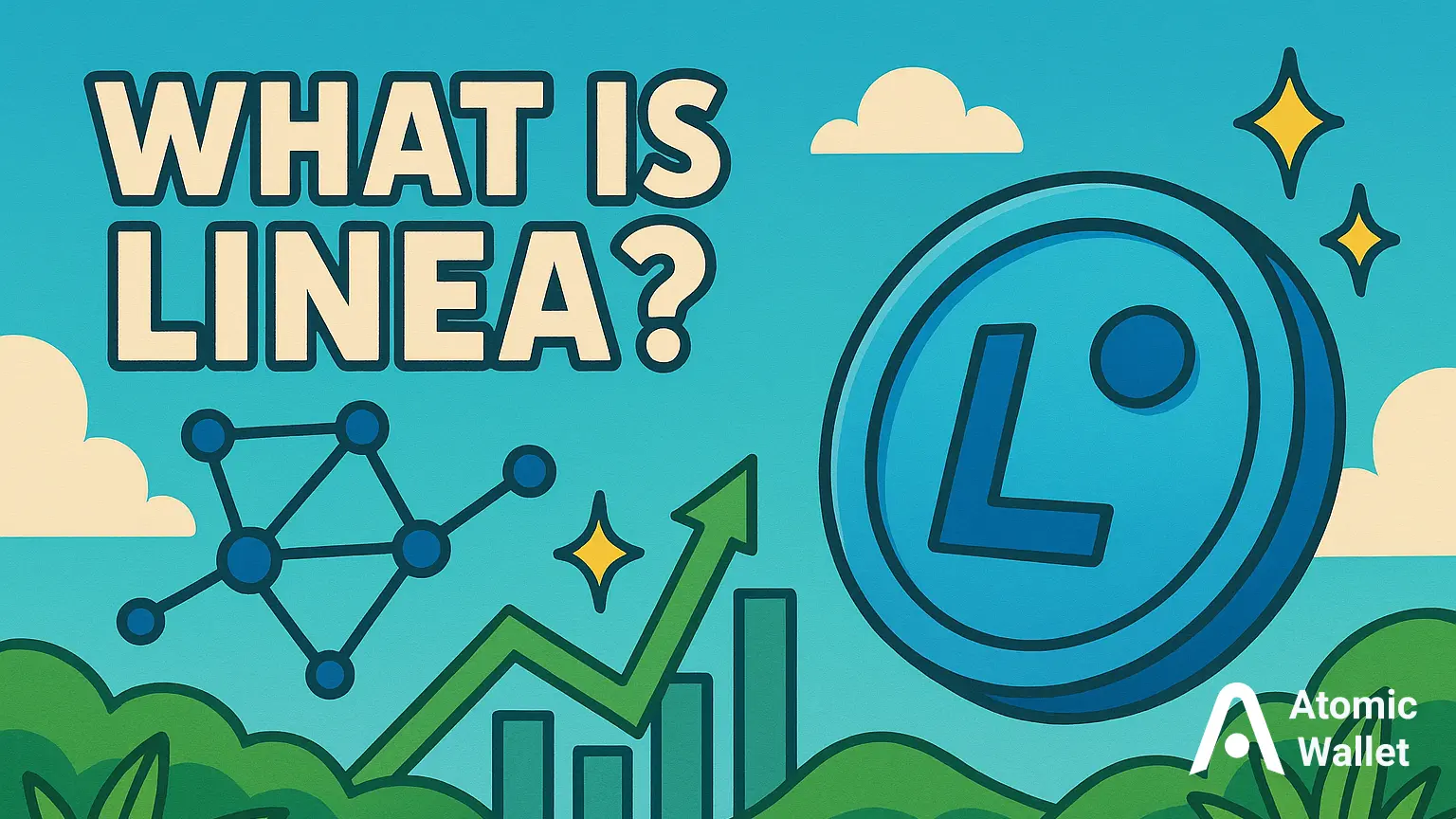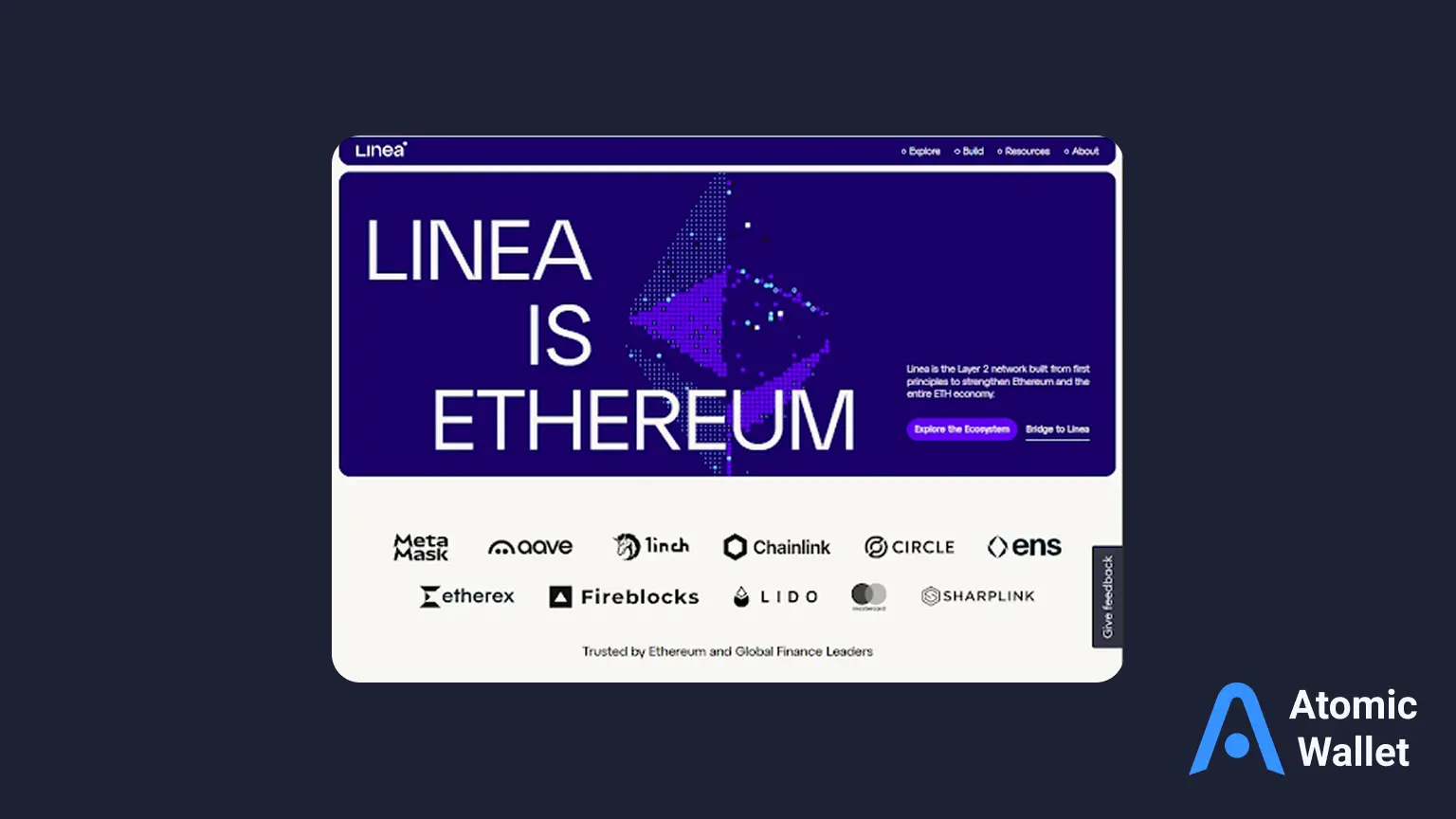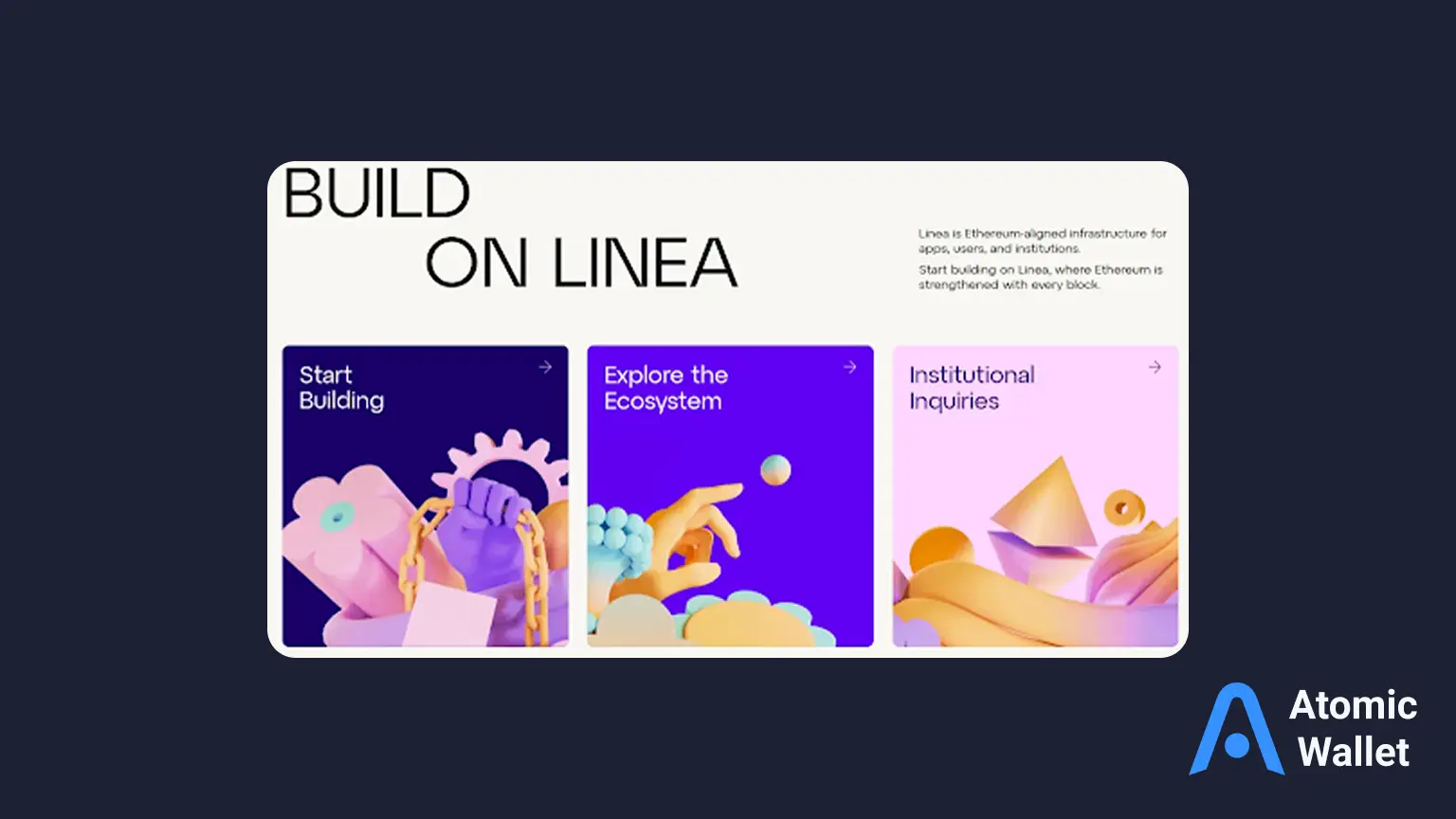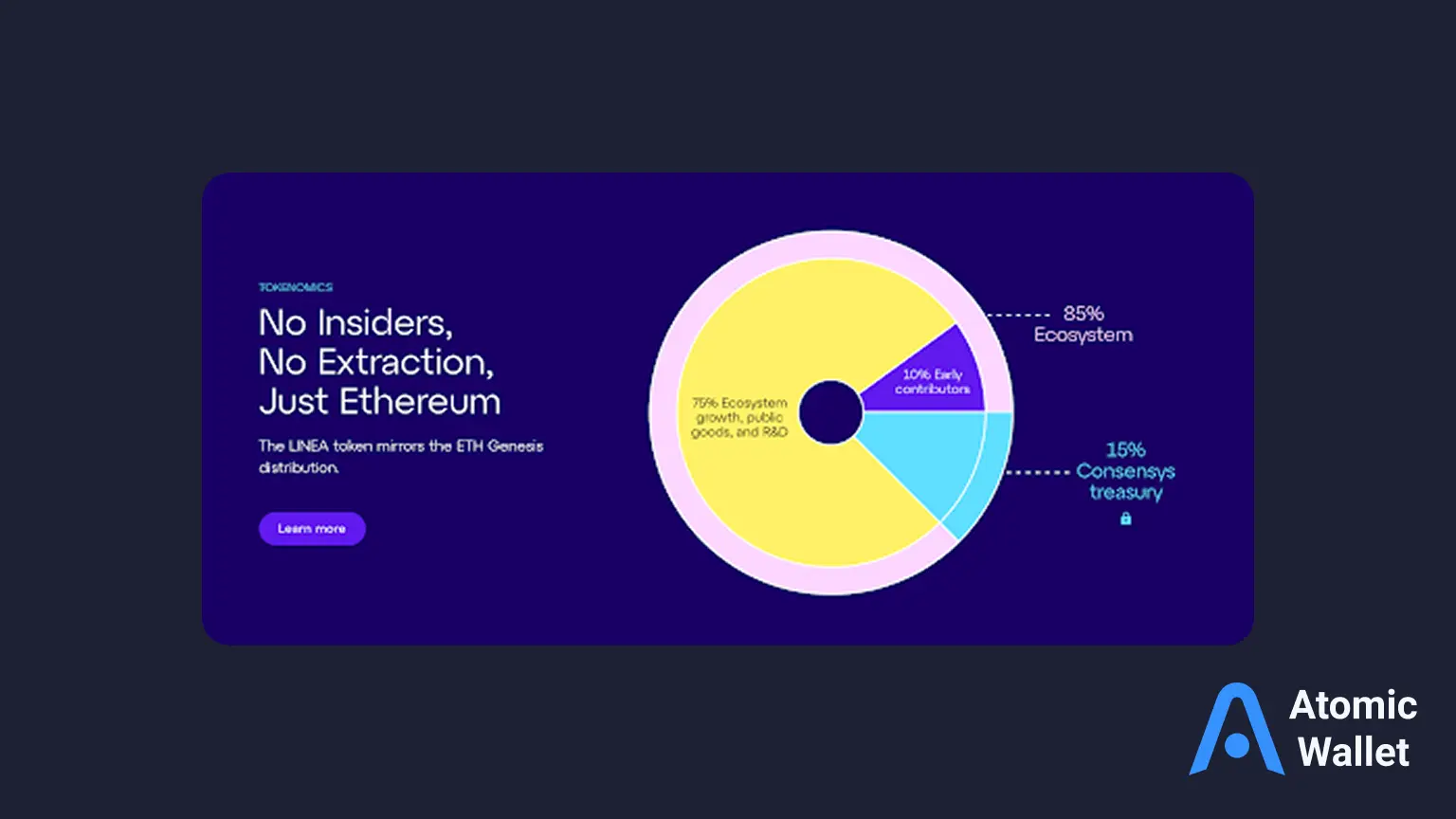Assets

Exchange

Buy Crypto




Ethereum has remained the most widely used blockchain for decentralized applications (dApps) and smart contracts. However, it gained such popularity that it revealed some long-term challenges: network overload, gas fees, and reduced transaction speed under load. The search for solutions that retain Ethereum’s security while removing its limitations has led to the rise of Layer 2 networks.
Linea, created by ConsenSys, the company behind MetaMask and other essential Web3 infrastructure tools, stands out as one of the most prominent. Linea combines zkEVM rollup technology with full Ethereum compatibility, allowing developers to scale applications without rewriting code.
In this detailed guide, we discuss the technical architecture, features, ecosystem and the potential of Linea in Web3 adoption. It also discusses the integration of Linea with Atomic Wallet, where it is possible to securely store and stake supported crypto.
Linea is a Layer 2 block chain which is designed to scale the capacity of Ethereum without trading off the security model. This is done through zero-knowledge rollups (zk-rollups) that groups transactions off-chain and present them to Ethereum as a single proof.

The most important benefit of this method is effectiveness. Aggregating transactions saves loads of data in the storage of the main chain in ethereum, drastically. The result is reduced gas costs, improved confirmation time and the potential to conduct thousands of transactions every second.
As a developer, Linea is Ethereum Virtual Machine (EVM) equivalent in its entirety. Current smart contracts, DeFi protocols, and NFTs on Ethereum can be migrated to Linea without modification to code. The network also supports the same toolkits that developers are currently using already on Ethereum tinyDNS such as MetaMask, Truffle, Hardhat, and Foundry, which reduces adoption costs.
Layer 1 is the primary layer of Ethereum that gives decentralization and security to it but is only capable of handling a few hundred transactions per second. Fees are high during high demand and the network speeds slow.
Layer 2 solutions are created with the aim of alleviating this congestion. They also perform transactions not on the main chain but still heft the outcomes to Layer 1. This involves less work-load on Ethereum and enhances user experience.
Linea is based on a zkEVM, a pairing of zero-knowledge proofs and complete EVM compatibility:
The architecture allows Linea to scale and provide the security assurances and decentralization of Ethereum.
Linea matches Ethereum’s execution environment exactly. Developers can deploy smart contracts as they would on Ethereum without any compatibility workarounds.
By processing transactions off-chain and only committing proofs to Ethereum, Linea reduces gas fees significantly. This is particularly useful for DeFi platforms where transaction costs can erode profitability.
Linea employs zkSNARKs, a type of zero-knowledge proof that verifies transactions efficiently. These proofs are small, fast to verify, and resistant to fraud.
The network is designed to interact with other blockchains, enabling cross-chain transfers and integration with various ecosystems.
Many projects of various sectors have appeared to Linea since the day of its launch:
Such integrations make Linea an open-ended DeFi, NFTs and more.
The architecture of Linea is constructed in such a way that it maximizes speed and security:
This modular solution enables the network to replace its part without interfering with operations.

Token distribution can make or break a blockchain project. Linea’s tokenomics aim to avoid insider dominance and ensure long-term sustainability.
This mirrors Ethereum’s Genesis distribution, emphasizing fairness and decentralization. By dedicating most of its tokens to community and ecosystem growth, Linea positions itself as a network built for long-term adoption rather than short-term extraction.

Linea’s design allows it to integrate with non-custodial wallets, giving users full control over their assets. Atomic Wallet offers secure storage for supported cryptocurrencies and staking for eligible coins.
When staking with Atomic Wallet:
This approach aligns with Linea’s decentralized ethos — allowing users to participate in network consensus or other staking-supported assets without compromising control.
Start Atomic Wallet and click on Receive.
Type ETH and select the one on the Linea network.
Paste your deposit address or utilize the in-app exchange right in Linea to get supported assets into ETH.
Then, you will be able to use dApps and services within the Linea ecosystem and keep your funds controlled.
The mix of scalability, low costs and EVM equivalence in Linea puts the latter at the forefront in the Layer 2 race. It can speed the adoption process by relieving developers to port applications without modification. It provides the security of Ethereum in cheaper and faster transactions to the users.
Provided that adoption maintains current rates, A line may become a more significant infrastructure layer of Web3 supporting decentralized financial services to metaverse applications.
How is Linea unique compared to other Layer 2 solutions?
Complete EVM compatibility, scalability by way of zk-rollunits, and developer tooling.
Can I save and stake Linea related assets in Atomic Wallet?
Yes, Atomic Wallet allows to safely store and stake eligible assets in a non-custodial manner
Will staking with Atomic Wallet mean that I give up my coins control?
No. You leave them to be backed up, and you prefer to protect your personal keys in your gadget
Can you use Linea in the Ethereum wallets?
Yes, it is compatible with some popular Ethereum wallets and Atomic Wallet among them.
Does Linea ecosystem have many projects?
more than 100 projects in DeFi, NFTs, and cross-chain infrastructure.
Linea leverages the established security of Ethereum along with zkEVM scaling to provide faster, cheaper transactions. Its developer-friendly design, expanding ecosystem, and scalability to secure storage platforms such as Atomic Wallet are some reasons why it can soon be an attractive network to both builders and simple everyday crypto fans.
Having successfully centralized dApp deployment and provided user asset custody, Linea has the potential to be more than the additional Layer 2, it might be the Servant of the next era of Web3 applications.

Rumble stock price explained: recent performance, volatility factors, and 2025 projections. Learn how politics and creator economics drive RUM.

Metaplanet stock surged as the company doubled down on its Bitcoin strategy and even added 14,618 ETH. Learn what drives Metaplanet stock price, how mNAV works, key risks, and why investors call it the “Japanese MicroStrategy.”